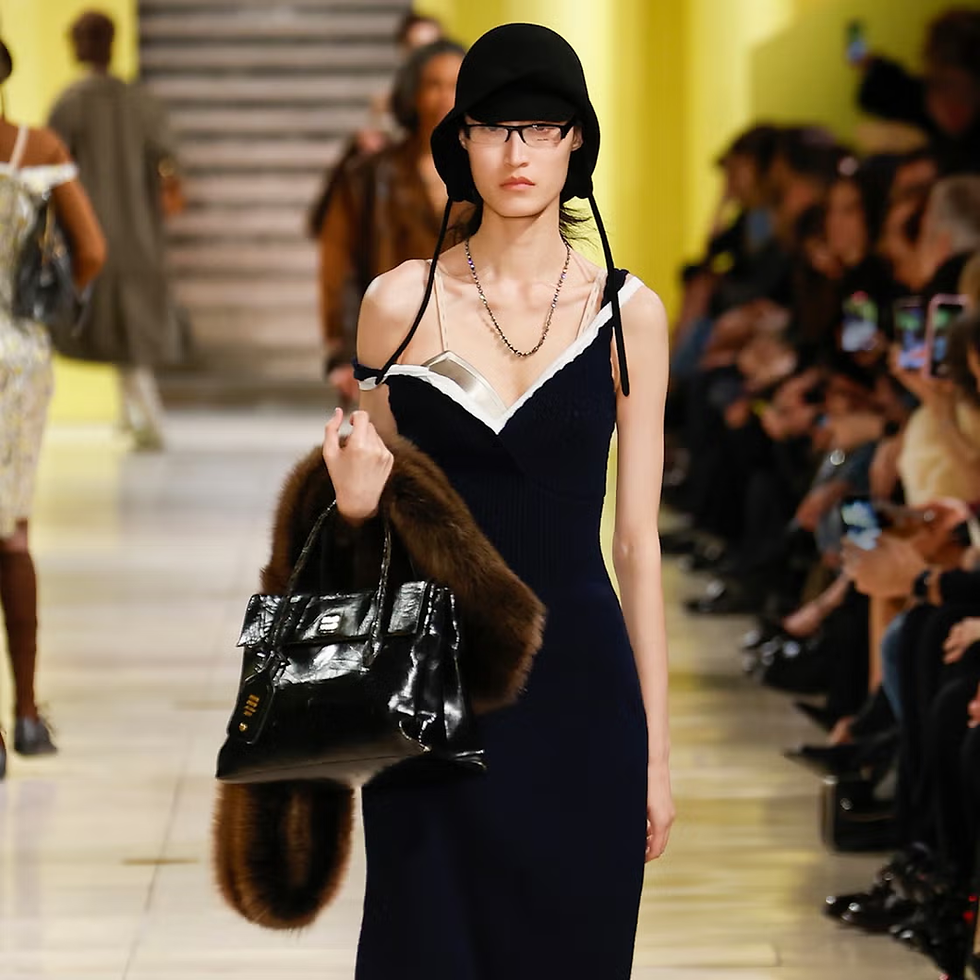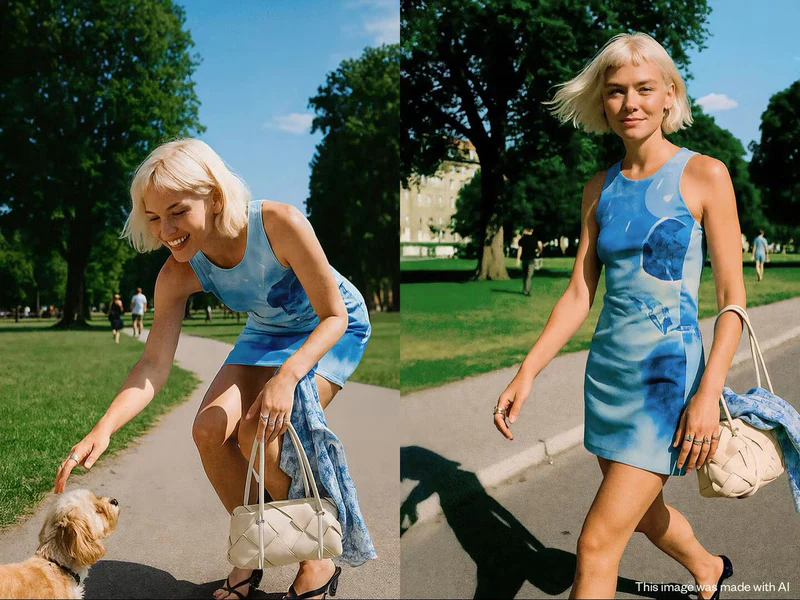Fashion: Fashion Rebellion: How Social Media Algorithms Spark a New Wave of Individualism and Challenge the Industry
- InsightTrendsWorld

- 3 days ago
- 6 min read
Why it is the topic trending: "Algorithm Angst and the Rise of Fashion Rebellion"
Algorithmic Homogenization: Social media platforms' algorithms amplify sameness, pushing users toward popular, easily digestible looks that often lack true individuality. As a result, there's a growing backlash from style leaders and consumers longing for authenticity.
Viral Pushback: Influencers and fashion-forward consumers are increasingly vocal about their fatigue with algorithm-driven style cycles, driving a surge in discussions around breaking free from “mainstream” social fashion.
Emergence of Anti-Trends: Micro-communities championing "anti-trend" or "anti-algorithm" fashion quickly go viral, illustrating a growing movement to reclaim creative autonomy and celebrate sartorial difference.
Consumer Fatigue: The churn of hyper-trendy items (like the rapid viral rise and fall of brands/products on TikTok or Instagram) leaves consumers seeking more lasting, personal approaches to style.
Overview: "Individualism Strikes Back—Inside the Anti-Algorithm Fashion Renaissance"
Never before has fashion felt so uniform—yet so ripe for disruption. As social platforms dictate what’s ‘in’ through data-fueled recommendations, a swelling resistance has emerged: style insiders and everyday dressers are actively rebelling against algorithm-engineered sameness. This phenomenon, rooted in both nostalgia and digital disillusionment, sees young consumers and creatives tapping vintage, DIY, or “weird” pieces that refuse the scroll-approved mold. Brands and retailers must grapple with an environment where algorithms build visibility, but their audience increasingly craves unpredictability, integrity, and meaning. The result is a new era for fashion—one where rebellion isn’t just tolerated, it’s celebrated.
Detailed findings: "Unpacking the Anti-Algorithm Fashion Movement"
Algorithm Overload: Social feeds reward replicable, viral styles and brand "dupes," resulting in a flattening of personal style.
Return to Roots: Consumers re-embrace thrifting, vintage shops, small makers, and platforms like Depop for unique finds that sidestep mass approval.
DIY & Customization: Bespoke alterations, upcycling, and unique “hacks” are trending among Gen Z and Millennials, showing a renewed appetite for originality.
Micro-Community Formation: Niche subcultures—Gorpcore, Y2K revivalists, retro futurists—flourish in algorithm-resistant corners of the internet, carving out space for alternative creativity.
Pushback by Influencers: Notable influencers and editors openly critique the homogenizing effect of “the algorithm,” advocating for individuality and spotlighting lesser-known brands.
Key success factors of product (trend): "How to Ride the Fashion Rebellion Wave"
Authenticity: Products with a story, origins, or hand-made elements stand out amid algorithmic sameness.
Limited Editions and Drops: Scarcity creates desirability in a sea of always-available “viral” looks.
Support for Self-Expression: Brands offering customizable, modular, or upcyclable pieces empower consumers to differentiate themselves.
Community Engagement: Brands deeply tuned into emerging micro-communities build lasting loyalty, rather than chasing the next viral hit.
Transparency: Products that clearly communicate process, origin, and ethics align with the anti-homogeneous attitude.
Key Takeaway: "Owning the Unpredictable—Brands and Consumers Rewrite the Rules"
The next era of fashion is both a reaction to and a product of the algorithm. While algorithms still drive some trends, the true icons are those who actively rebel, seek rarity, and challenge mass-market aesthetics. For brands, the future lies in real engagement, ethical storytelling, and empowering individualism rather than betting everything on the next viral moment.
Main Trend: "Algorithm Rebellion—From Viral Uniformity to Celebrated Difference"
The overwhelming influence of social algorithms on fashion choices has sparked a widespread desire to break free. “Algorithm rebellion” is the defining trend, with consumers and tastemakers alike choosing 'strange,' 'personal,' and 'bespoke' over the status quo. The fashion conversation is quickly shifting from what sells to what stands out.
Description of the trend: "Anti-Algorithm Fashion Rebellion"
The Anti-Algorithm Fashion Rebellion sees style-conscious consumers and creators deliberately sidestepping algorithm-endorsed trends. It is characterized by a preference for unique styling—vintage pieces, customized garments, DIY-heavy outfits, and support for small or local makers—over viral bestsellers. The movement is as much psychological as sartorial: it embodies resistance to digital fatigue, and celebrates a more meaningful connection to one’s wardrobe.
Key Characteristics of the Core trend: "Defining Traits of Anti-Algorithm Style"
Deliberate Divergence: Choices made in direct opposition to viral popularity or platform curation.
Vintage & Upcycled Domination: Emphasis on pre-loved, thrifted, and upcycled garments for their uniqueness and backstory.
DIY & Customization: Visible alterations—stitched patches, painted jackets, hacked thrift finds.
Micro-Trend Flourishing: Cult aesthetics and hyper-niche styles thrive in small, highly engaged communities.
Story-Driven Style: Personal stories, maker narratives, and visible individuality drive preference over “likes.”
Market and Cultural Signals Supporting the Trend: "Culture Craves the Unpredictable"
Resale Platform Growth: Depop, Vinted, and vintage marketplaces experience continued boom.
Influencer Discourse: Popular creators critiquing mainstream “algorithmic” fashion.
"Core" Movements: Rapid emergence of hyper-niche trends (e.g., Nerdcore, Weird Girl Aesthetic) spotlight appetite for difference.
Anti-Haul & De-Influencing: New social content categories that actively dissuade adherence to mass-market viral products.
Media Spotlight: Growing number of think pieces and editorials dissecting the cost of algorithmic sameness.
What is consumer motivation: "Why Break Free from the Algorithm?"
Quest for Authenticity: Yearning for style that signals true self, not just algorithmic approval.
Desire for Rarity: Finding satisfaction in owning/wearing something nobody else has.
Individual Expression: Need to stand out in a digital sea of similarity.
Sustainability Goals: Thrifting and upcycling as environmentally sound alternatives to fast-fashion churn.
Rebellion & Identity: Individuality as a form of digital and cultural resistance.
What is motivation beyond the trend: "Deeper Drivers Behind the Anti-Algorithm Wave"
Digital Fatigue: Weariness from rapid trend cycling and social media sameness.
Desire for Community: Micro-groups give social affirmation not linked to mass approval.
Cultural Cynicism: Pushback against algorithmic manipulation and the commercialization of individual taste.
Empowerment: Customization and DIY foster a sense of agency and pride.
Experiential Value: Unique and “storied” fashion items yield deeper connection and memory value.
Descriptions of consumers: "The New Fashion Individualists"
Consumer Summary:
Composed of digitally-aware, style-driven shoppers who are unimpressed by mass trends and actively seek newness and authenticity.
These consumers are often leaders within their peer groups, influencing smaller micro-communities both online and offline.
They demonstrate creative agility, swiftly adopting and remixing trends that feel personal, rather than prescribed by an algorithm.
They value sustainability, meaningful consumption, and experiences over simply following the crowd.
Further Insights:
Frequently mix vintage, new indie labels, and self-made pieces.
Highly skilled at navigating re-sale and niche marketplaces.
Are outspoken—often fueling online dialogue against the status-quo and elevating lesser-known talent.
Detailed summary (based on experience and article):
Who are they? Fashion-forward, style opinion-leaders, Gen Z and Millennials primarily, but also inclusive of older style rebels.
What is their age? Largely 16–40, but the underlying motivation for individuality spans all ages.
What is their gender? All genders participate; resistance to algorithm-driven uniformity is universal.
What is their income? Mixed; while some have disposable income for rare vintage or artisanal goods, many make an impact by upcycling thrift finds or DIY.
What is their lifestyle? Culturally plugged-in, digitally active, often urban. They seek meaning, community, and creative outlets in both online and offline worlds.
How the Trend Is Changing Consumer Behavior: "Disrupting the Fast-Fashion Playbook"
Less Impulse, More Discovery: Shoppers prioritize the thrill of unique finds over one-click viral purchases.
Skill-Driven Shopping: Increased interest in thrifting, altering, and swapping—shopping as skill and community, not just acquisition.
Content with Depth: Longer-form, story-driven posts and “how-I-styled” tutorials challenge the algorithm’s preference for fast, visual content.
Deeper Brand Scrutiny: Consumers research and interrogate brands for authenticity and creativity.
Spread of 'De-Influencing': Audiences increasingly seek, and share, content that dissuades from mass consumption.
Implications of trend Across the Ecosystem: "Fashion's Great Reshuffle—Impact at Every Level"
For Consumers:They gain more satisfaction, creativity, and pride through discovery, curation, and customization. However, it can be more time-intensive and challenging to stand out with true originality.
For Brands & CPGs:Pressure mounts to offer authentic stories, limit edition product runs, and spotlight genuine creative collaborations. Brands relying solely on algorithm-optimized marketing risk appearing irrelevant or copycat.
For Retailers:Success lies in curation, experience, and local flavor—vintage stores, pop-ups, and “maker” markets outshine undifferentiated chains. Digital platforms must engineer discovery beyond algorithmic suggestion.
Strategic Forecast: "The Next Wave—Craft, Collaboration, and Community"
Curated Micro-Collections: Expect brands to launch highly curated, story-driven drops collaborating with real-life tastemakers and artists.
Tech-Enhanced Customization: Tools for digital garment customization or “co-design” become mainstream.
Circular Fashion Booms: Continued growth of re-sale, rental, and upcycling platforms.
Influencer Re-alignment: New breed of influencers gain prominence through “de-influencing” and discovery, rather than sponsored clones.
Narrative-Driven Marketing: Brand growth hinges on true storytelling and community engagement over viral dance trends or paid influencer blitzes.
Areas of innovation: "Where Fashion’s Rebels Lead Next"
Virtual Thrifting Platforms: Next-generation resell spaces leveraging AI to surface hidden gems—without bias toward viral products.
DIY Kits & Workshops: Brands offering kits, tools, and events for upcycling, customization, and garment repair.
Augmented Reality Style Stories: Tech that lets users overlay clothing customizations or vintage styling in AR before purchase.
Decentralized Trend Platforms: New digital communities and forums focused on sharing non-algorithmic looks and stories.
Sustainable Materials Innovation: Materials and processes that make upcycling or one-off creation more practical, affordable, and scalable.
Summary of Trends:
Core Consumer Trend:"Rebellion-as-Individualism"—Consumers champion anti-algorithm, expressive fashion, prioritizing unique personal curation over sameness.
Core Social Trend:"Micro-Community Flourishing"—Small, deeply engaged groups set trends, championing difference and challenging mainstream visibility.
Core Strategy:"Limit, Narrate, Engage"—Winning strategies revolve around scarcity, authentic narratives, and direct engagement—less about mass reach, more about meaningful connection.
Core Industry Trend:"Algorithm Pushback"—The market pivots away from algorithm-dictated, homogenous offerings, instead rewarding curated, crafted, niche alternatives.
Core Consumer Motivation:"Expression As Resistance"—Fashion is increasingly a tool for resistance and self-assertion in the face of digital sameness.
Final Thought: "Fashion Beyond the Feed—A Creative Rebellion Gains Steam"
The anti-algorithm movement in fashion isn’t just a style phase—it’s a cultural recalibration. As consumers tire of sameness and digital fatigue, they seize power from algorithms, crafting meaning, memory, and community from their clothes. The brands that thrive will be those that refuse to chase the feed and, instead, help their audiences rebel—one story, stitch, and standout piece at a time.




Comments